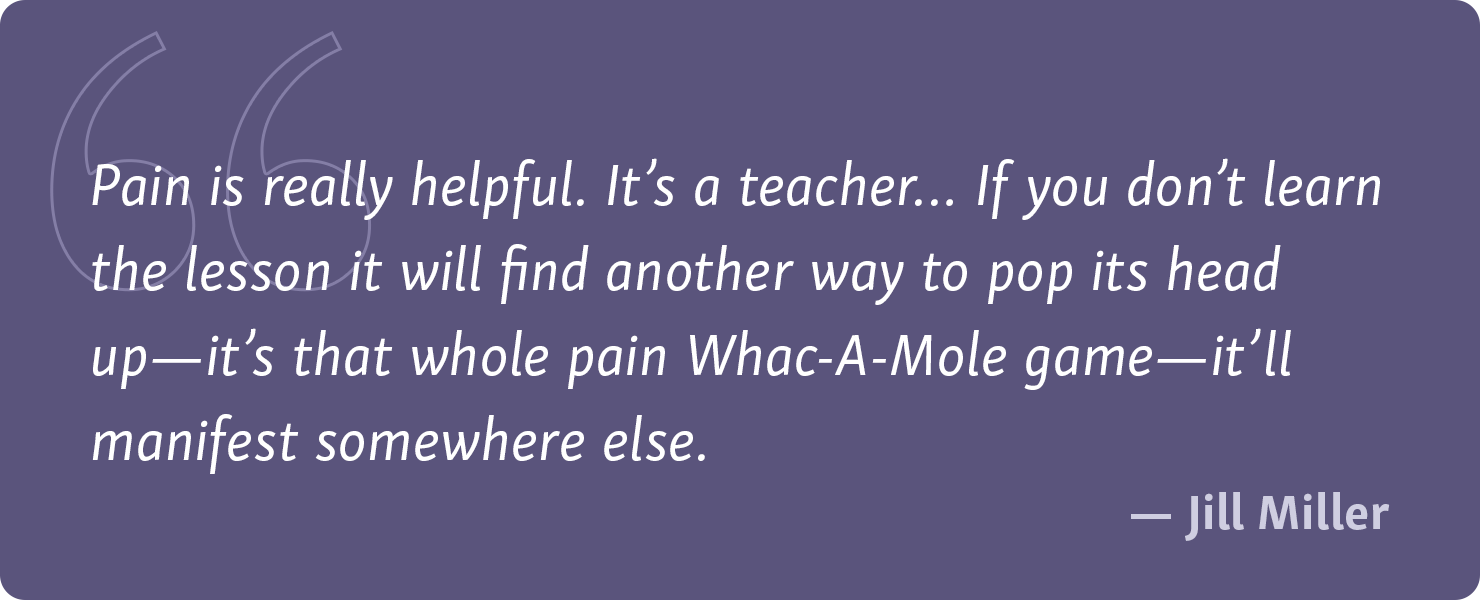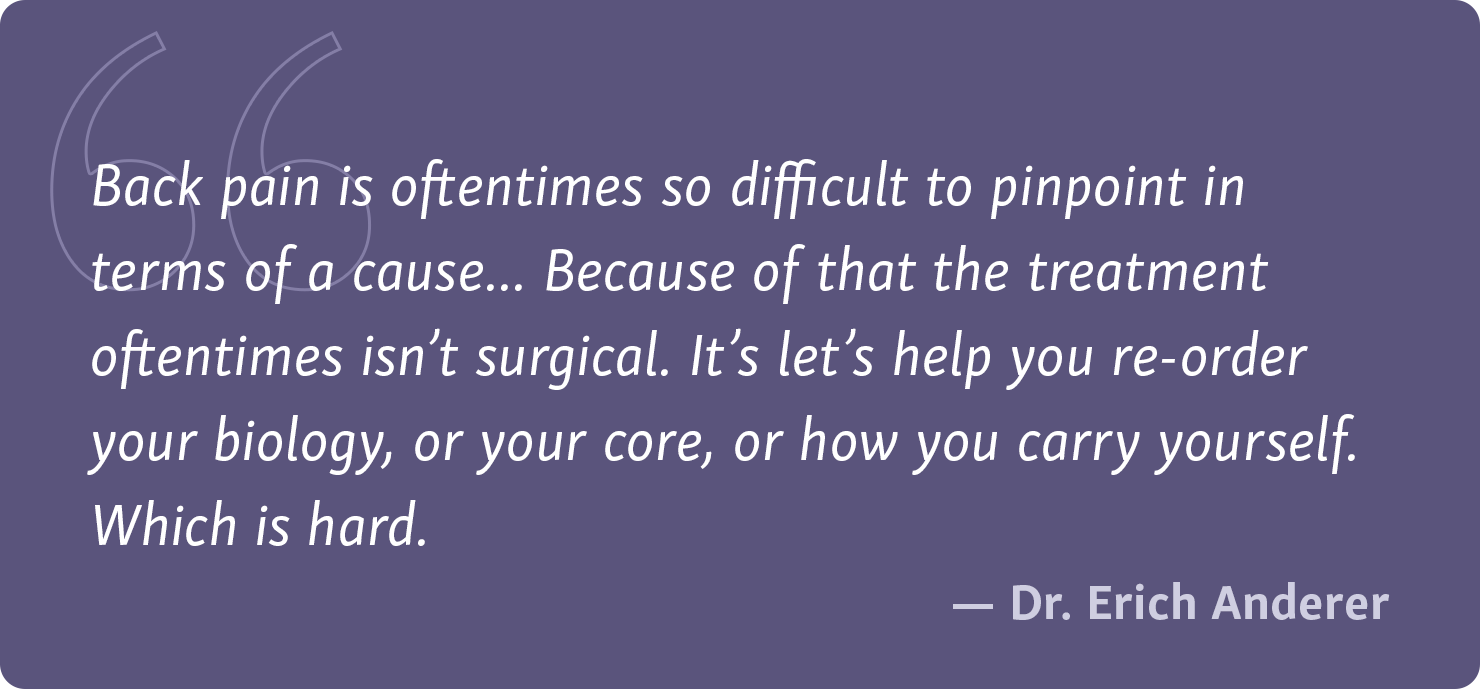
Tune Up Fitness® program creator Jill Miller and Brooklyn-based neurosurgeon Dr. Erich Anderer are each leaders in their own respective fields. However, they offer very different services to help heal pain and optimize health.
Miller designs self-directed movement, self-massage and mindset practices that fall under the heading of “self-care.” While Anderer performs spinal surgeries. Yet, they have remarkably similar perspectives on what healing from pain and injury ultimately boils down to: You.
The Power of a Personalized Health Education
In a recent conversation between Miller and Anderer, the power of you, the individual, to drive your own healing process forward became obvious. Here are five ways to better understand your pain and boost your path to healing.
1. Believe in Your Own Healing Process
Both Anderer and Miller advocate for you personally engaging in your healing process–to cultivate the perspective that you are an active participant in your path to wellness.
“People aren’t going to get better without buy-in,” shared Dr. Anderer. “And it’s got to be real buy-in. The idea with any intervention, even nonsurgical interventions, is that someone else or something else is going to fix me… I’m pitting all my hopes on this one technique. But the way you have to think about it is I’m going to do it, I’m going to make my body better. So it’s not this idea that you fix me, it’s you gotta fix yourself.”
“It boils down to them wanting” Miller added, “them wanting to live better than how they’re living. If they want this change, then it sets them looking for resources.”
Both Miller and Anderer acknowledge that we all need the help of others from time-to-time for both big procedures, like a surgery, or simple rehab instructions, such as fitness therapy.
“But,” says Miller, “the bottom line is it’s costly to rely on others to always fix your stuff. And they can’t do it. Because the healing never is somebody else healing you. You’re the knowing organism that hosts its own self-healing. Your implicit biology adapts and self-repairs.”
2. Find the Bravery to Sense Yourself
Miller’s work revolves around shaping personalized solutions for self-care, all of which begin with somatic explorations into the often unheard, or repressed messages she calls “blind spots” that the body holds. Her initiation into seeking answers within originated in her work to heal from her own bulimia.
“Looking back on my late teen years when I was a bulimic, I learned the value of self-massage,” said Jill. “I was doing talk therapy for the bulimia, but it wasn’t until I actually started to experience what my body was feeling–not just what my mind was thinking–by doing self-massage in my gut, that there was a direct connection between what my body was feeling and how to speak its voice. So that has been a fundamental, a CORE, of all of this work.
“Ultimately all of Tune Up Fitness work is about leading other people to be able to do best self-care practices on themself so they don’t need to be led, they lead themselves.”
If you find yourself in one of Miller’s classes you’ll likely hear her call out, after teaching a self-massage technique: “You don’t need me, you knead you!”
So what can you do to “knead” yourself? Embark on getting to know the messages your body holds through self-massage. Or explore other self-care practices like stretch, conscious movement, meditation and more. This way you will build your own personalized health education.
Dr. Anderer is a big advocate of meditation and other practices that enhance the connection between mind and body. He suggests “even just taking time during the day for reflection and breathing exercises.”
This choice to sense yourself and learn to trust what you feel often takes bravery. But a shift in mindset about the role of pain in your life could help build your courage to embark on these practices…
3. See Your Pain as a Teacher… and Learn From It
It’s natural to want to avoid pain. After all, it hurts! However, in seeking long-lasting solutions it is helpful to shift from just thinking of pain as bad and needing to get rid of it. Instead, see your pain as a prompt to start learning more about its cause, and what it is pointing back to.
“Pain is really helpful,” offers Miller. “It’s a teacher….There is an unwinding and re-winding that needs to happen to reverse-engineer what’s causing that pain to persist. And if you don’t learn the lesson it will find another way to pop its head up–it’s that whole pain Whac-a-mole game–it’ll manifest somewhere else.”
Miller’s programming is built on her passion for providing methodology that helps shape this new attitude toward pain: “Our Tune Up trainings, workshops and teachers are sneaky and stealth in helping people be better listeners and attune to their own signals: The good and the uncomfortable. The sublime and the terrifying. And slowly but surely over time, remodeling your body into one that’s more versatile and fun to be in–and for the most part, pain free.”
4. Accept That the Symptoms Might Be Very Different From the Cause

This is because the pain you experience could be more complex than meets the eye. It might need to be addressed from several different angles.
“Part of the problem with back pain is it’s so difficult oftentimes to pinpoint in terms of a cause,” says Dr. Anderer. “Because most of the time it doesn’t have to do with something specifically structural. Usually it’s some kind of interplay between your ligaments, your muscles and your joints that you’re not going to diagnose on an MRI. And because of that, the treatment oftentimes isn’t surgical. It’s let’s help you re-order your biology, or your core, or how you carry yourself. Which is hard.”
So basically, working toward a solution could involve addressing postural or movement issues that seem quite distant from the actual symptoms you are experiencing. Furthermore, the issue could be rooted in an acute or developmental trauma that doesn’t have a physical imprint on the body, but still has an energetic presence.
By opening your mind to the possibility that the symptoms you are experiencing could have a very different cause than you first thought, you make it possible to get to the root of the issue, to find resolution there.
5. Consider the “Downstream Effects” of Your Choices
Dr. Anderer lent some fascinating perspective, from the world of medicine, regarding the role of painkillers such as the swell of opioid prescriptions and usage in present times.
“The opioid thing has been ingrained in the hospital system, provider system and the general public by a lot of people–some well-meaning some not. The general idea is that if the physician is not treating the pain adequately, to the point that your patient satisfaction scores don’t reflect that you’ve been given something to get you out of pain, then your doctor isn’t doing a good job and it’s malpractice.
“I think that has been internalized by both physicians and the general populace. Most of the physicians are well-meaning and think, if I’m not treating my patient’s pain with the best thing possible–and opiates are a great pain medication–then I’m doing them a disservice.
“Then, on the other hand, people are looking for something that’s a quick fix, something to make them feel better, while not necessarily grasping all of the downstream effects of being on opiates. Most of which end up being far more detrimental to you as a human being than whatever the original problem was.”
Much of Dr. Anderer’s messaging to patients, that show up in his office or listeners who call in to his Sirius XM show on Doctor Radio, is about encouraging the public to seek alternative solutions beyond pain medication and surgery: To make strong meds and/or surgery a last resort.
He is working to send the message to the general public that “there are other things that can be done and that are more empowering because they are done by you, not by a pill.”
Both Miller and Anderer acknowledge that a surgery, medication or other Western medicine approaches are absolutely necessary at times. But the message that they also seem to want to get out there, is that there are many ways to build trust and understanding in your physiological self… which is well worth the effort.
Author & Interviewer: Ariel Kiley















Great article – really good to hear about the importance of the person realizing they are the one who must heal themselves coming from both a self-care and western medicine perspective. In my experience, this is where all healing must start. The other points about pain being a great teacher, how symptoms may be very different from causes, and the lack of consideration typically given to downstream effects are also great. Thank you for teaming up to provide these perspectives!
Self care the better care and way to prevent furthers health problems
Thanks
Empowering people who suffer pain is the best help they can receive. People often put all their hopes in that someone else is going to cure them, when in reality all they need to become healthier is inside them. The body has the intelligence to cure itself. Love this article and the focus on personalize health education.
Excellent article again. I have the power to heal myself should be a Sankalpa taught from childhood!
As a Medicine Person trained and Certified in Traditional Algonquin Medicine and Angelic Shamanism, I can whole heartedly agree that we are the only ones who can heal ourselves and that our stories live inside us, definitely manifest until they are directly faced on all layers and levels. Another interesting and great read. Thanks.
Blessings
Melaina
This article provides the foundational element to everyone’s well being. The thing we often overlook is how intuitive our bodies are and the fact that every answer to optimizing our being is within our selves. Of course I need a kick in the sits bones to get back on track from time to time and that’s why I value mentorship and having multiple coaches or experts to lean on. But ultimately what our body, mind and spirit needs is hard to find when we dont tune in and this is why I love Tune Up and Jill Miller’s practices because it provides exploratory tools that facilitate a an environment where it is easier to find the answers to improving our wellbeing. Awesome article, i will be sharing this with my students and loved ones. Thank you
I’ve read few Yoga Tune Up articles and i loved each one of them! The articles are so informative and helpful and really resonate with me. This one requires thinking and analyzing your life choices and trying to make right ones. It’s so crucial to take care of yourself!
This article advocates for us to participate in our healing. It’s so true that the best health strategy is an individualized and personalized education of health. The body often gives more honest feedback than the mind but it requires more listening and more time. This article hones in on the fact that our ailments and the landscape of our health is often more complex than an individual symptom or perceived ailment. A reminder to find a balance between knowing and trusting your system and looking at your health in a holistic, comprehensive way.
The empowerment of understanding and being able to manage physical pain translates into our emotional lives as well. Sitting with a sensation, identifying it, and treating it with care is a beautiful model for every kind of self care.
YES! I couldn’t agree more. Our health and healing can only really happen when we believe in our body’s ability to heal itself. Having support from many different resources is great and a great tool, but until we believe and essentially become our own “magic cure”, we will forever look to someone or something else to heal us, when we already contain all we need. I really believe going beyond the physical is so essential as well, as so many physical symptoms are manifestations of something deeper and absolutely not to be ignored or suppressed with pills upon pills.
Thank you!
As a yoga student I have learned to listen to what the body is saying through the various poses. We as society must embrace the power of self healing to try and reduce the need for prescription drugs and pharmaceutical companies
I work with many of my own patients emphasizing pain as a teacher and guide. It’s not fun. We wouldn’t wish it on ourselves. But some of our biggest breakthroughs and moment of personal evolution come from our biggest face plant moments. And in this world of instant gratification, we forget our own resourcefulness. Thanks for reminding us of our own power to change from within, to access the health that is already there.
Nice Blog
As an aspiring wellness coach I have learned about the Bio-individuality of our health. A holistic approach, as clearly taught in Yoga, can be very helpful in this. It is empowering to realize we are the master of our own temple. We need to be our own advocates and focus listening to our own bodily and spiritual needs and demands.
Very good Information. As a society we want a quick fix with a quick pill. Slowing down to actually sit with your symptoms and sit with your body, is very difficult for some people. To realize we must find the real source of the pain, or it will reappear somewhere else is a lesson each of us must take to heart. Thanks for this wonderful article.